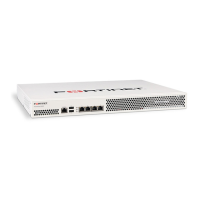Fortinet Technologies Inc. Page 8 FortiVoice 200D/200D-T v2.0 MR1 CLI Reference
You can do this using either:
• a local console connection (see the following procedure)
• the web-based manager (see the FortiVoice Setup and Administration Guide)
Requirements
• a computer with an available serial communications (COM) port and RJ-45 port
• terminal emulation software such as PuTTY
• the RJ-45-to-DB-9 or null modem cable included in your FortiVoice package
• a network cable
• prior configuration of the network interface and static route (for details, see the FortiVoice
Setup and Administration Guide)
To enable SSH or Telnet access to the CLI using a local console connection
1. Using the network cable, connect the FortiVoice unit’s network port either directly to your
computer’s network port, or to a network through which your computer can reach the
FortiVoice unit.
2. Note the number of the physical network port.
3. Using a local console connection, connect and log into the CLI. For details, see “Connecting
to the CLI using a local console” on page 6.
4. Enter the following commands:
config system interface
edit <interface_name>
set allowaccess {http https ping snmp ssh telnet}
end
where:
• <interface_str> is the name of the network interface associated with the physical
network port, such as port1
• {aggregator http https ping ssh telnet webservice} is the complete,
space-delimited list of permitted administrative access protocols, such as https ssh
telnet; omit protocols that you do not want to permit
For example, to exclude HTTP, SNMP, and Telnet, and allow only HTTPS, ICMP ECHO (ping),
and SSH administrative access on port1:
config system interface
edit "port1"
set allowaccess ping https ssh
next
end
Telnet is not a secure access method. SSH should be used to access the CLI from the Internet
or any other untrusted network.

